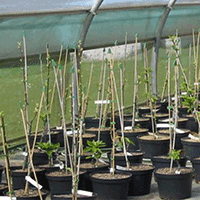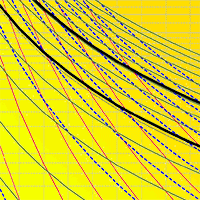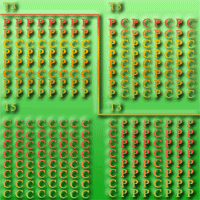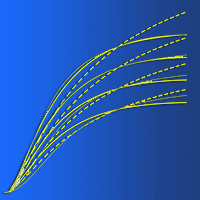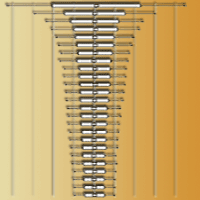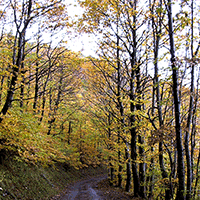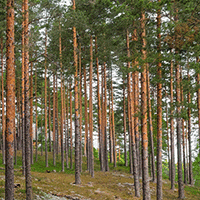
Density management diagrams for sweet chestnut high-forest stands in Portugal
Maria Sameiro Patrício , Luís Nunes
iForest - Biogeosciences and Forestry, Volume 10, Issue 6, Pages 865-870 (2017)
doi: https://doi.org/10.3832/ifor2411-010
Published: Nov 06, 2017 - Copyright © 2017 SISEF
Research Articles
Abstract
This study aims to develop stand density management diagrams (SDMDs) for pure even-aged high-forest stands of sweet chestnut in Portugal, defining the appropriate upper and lower limits of growing stock while considering the biological, technological and economic objectives that are expected for these stands. The SDMDs were developed with data collected from high-forest stands in northern Portugal, which is the main representative area of these stands in the country. Data were collected from 23 pure even-aged permanent plots with re-measurement intervals of 4-10 years, 43 semi-permanent plots and 18 even-aged temporary plots; all plots were established in chestnut high-forest stands with a broad range of ages. SDMDs were constructed by simultaneously fitting four nonlinear equations relating stand variables using the full information likelihood technique. SDMDs for the estimation of stand total volume, stand stem biomass, stand total aboveground biomass, and carbon content in aboveground biomass are presented as bivariate graphs with dominant height on the x-axis and the number of trees per hectare on the y-axis (using logarithmic scale). A tool is made available to define an optimal range of stand density for a silviculture oriented to single-stem selection on a tree-by-tree basis, focusing management on the most valuable trees. This tool is aimed to support forest managers in the decision-making process, enabling them to schedule thinnings on the basis of the dominant height growth of the trees with the greatest potential (frame trees), maintaining an adequate growing stock and assessing the corresponding aboveground wood volume, biomass, carbon, and mean diameter breast height.
Keywords
Castanea sativa Mill., Stand Density, Thinning, Biomass, Site Index, Dominant Height, Forest Management
Authors’ Info
Authors’ address
Luís Nunes
Mountain Research Centre (CIMO), School of Agriculture, Polytechnic Institute of Bragança. Campus de Santa Apolónia, 5300-253 Bragança (Portugal)
Corresponding author
Paper Info
Citation
Patrício MS, Nunes L (2017). Density management diagrams for sweet chestnut high-forest stands in Portugal. iForest 10: 865-870. - doi: 10.3832/ifor2411-010
Academic Editor
Andrea Cutini
Paper history
Received: Feb 15, 2017
Accepted: Aug 11, 2017
First online: Nov 06, 2017
Publication Date: Dec 31, 2017
Publication Time: 2.90 months
Copyright Information
© SISEF - The Italian Society of Silviculture and Forest Ecology 2017
Open Access
This article is distributed under the terms of the Creative Commons Attribution-Non Commercial 4.0 International (https://creativecommons.org/licenses/by-nc/4.0/), which permits unrestricted use, distribution, and reproduction in any medium, provided you give appropriate credit to the original author(s) and the source, provide a link to the Creative Commons license, and indicate if changes were made.
Web Metrics
Breakdown by View Type
Article Usage
Total Article Views: 48046
(from publication date up to now)
Breakdown by View Type
HTML Page Views: 39439
Abstract Page Views: 2854
PDF Downloads: 4659
Citation/Reference Downloads: 21
XML Downloads: 1073
Web Metrics
Days since publication: 2946
Overall contacts: 48046
Avg. contacts per week: 114.16
Citation Metrics
Article Citations
Article citations are based on data periodically collected from the Clarivate Web of Science web site
(last update: Mar 2025)
Total number of cites (since 2017): 13
Average cites per year: 1.44
Publication Metrics
by Dimensions ©
Articles citing this article
List of the papers citing this article based on CrossRef Cited-by.
References
Viveiros forestales y uso de planta en repoblación en Galicia [Forest nurseries and plant use in afforestations in Galicia]. Doctoral thesis (electronic publication), Universidad de Santiago de Compostela, Santiago de Compostela, pp. 261. [in Spanish]
Gscholar
The principles of forest yield study. SH Gardiner, Pergamon Press Ltd., Oxford, UK, pp. 506.
Gscholar
Estratégia nacional para as florestas [National forest strategy]. Direcção Geral dos Recursos Florestais, Lisboa, Portugal, pp. 136. [in Portuguese]
Gscholar
Modelling forest development. Kluwer Academic Publisher, The Netherlands, pp. 222.
Gscholar
IFN6 - Áreas dos usos do solo e das espécies florestais de Portugal continental. Resultados preliminares [NFI6 - Areas of the land uses and of the forest species in mainland Portugal. Preliminary results]. Instituto da Conservação da Natureza e das Florestas, Lisboa, Portugal, pp. 33. [in Portuguese]
Gscholar
Análise da Potencialidade Produtiva do Castanheiro em Portugal [Analysis of Sweet Chestnut Productive Potentiality in Portugal]. PhD thesis, Universidade Técnica de Lisboa, Instituto Superior de Agronomia, Lisboa, Portugal, pp. 273. [in Portuguese]
Gscholar
Tabela de produção para o castanheiro em regime de alto fuste [Yield table for sweet chestnut in high-forest system]. In: Proceedings of the “5th Portuguese National Forest Congress” (Silva R, Páscoa F ed). Viseu (Portugal) 16-19 May 2005, T2-27, pp. 1-7. [in Portuguese]
Gscholar

